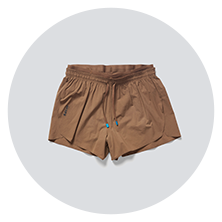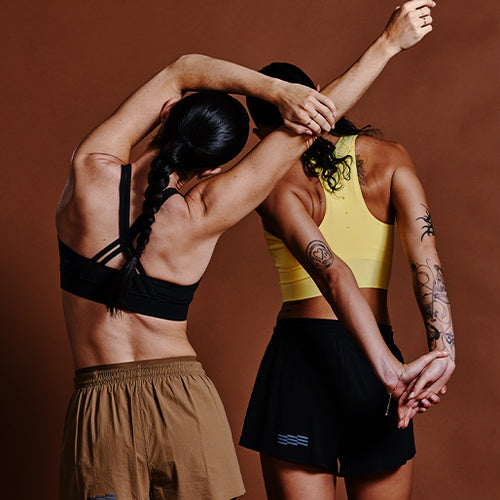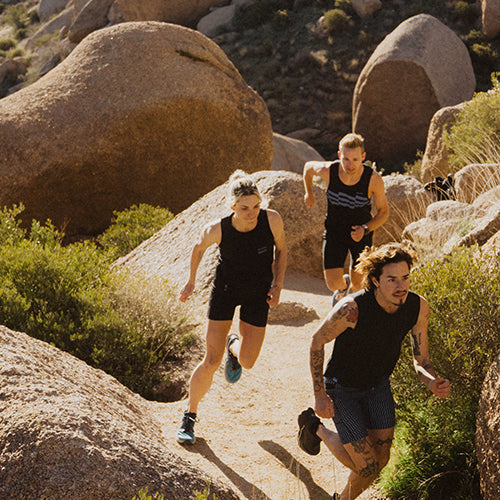Take a look at Andrew Catanese’s art, and you’ll immediately be struck by its vibrancy.
Seemingly endless shades of green set the stage for pops of color, organic yet a bit surreal. Take a closer look, and you’ll notice eyes peeping out at you, as the shapes of animals take form within the lush landscape. A jackrabbit peeps inquisitively between wildflowers and tall grass. A sheep glares through a circle of human faces. A frog and a snake hold each other’s gaze amidst a technicolor creekbed.
Andrew, who is nonbinary and uses they/them pronouns, thinks constantly about the encounters that bring us closer to our natural origins. As an ultra mountain runner and Janji Field Team member, they indulge this curiosity with trail runs around their California home that connect them with members of their natural community that they then depict in artwork, from snakes to black tail deer.
We chatted with Andrew to learn more about their art, running, and the myriad ways that they inform each other.
 
Husk, 2022.
|
 
Life of the Party, 2022.
|
 
Staring Contest, 2022.
|
Janji: What were some of the first things that piqued your interest in visual art?
Andrew: It’s hard for me to pinpoint when I became interested in doing art because it’s hard to remember when I wasn’t interested in doing art. I was seven when I did a school project where we had to figure out how to make a living doing our dream job, and my dream job was to be an artist.
It took me a while to figure out what was most exciting to me about making art. I always liked doing landscapes. But in art school I realized I didn’t really want to just do landscape paintings; Intellectually it’s not that exciting. I like to make work that’s beautiful, but I wanted there to be a little more to it than that. So trying to figure that out took some time, and now I’m painting landscapes again, but I know why I’m painting them. I mostly paint animals in landscapes now, so in a way it came full circle.
|
“As much as I enjoy competing and running, in general what gets me out there is this idea of feeling connected to the natural world, to animals and these landscapes.- Andrew |
 
|
J: Looking at your art, there are a lot of animals like frogs and salamanders. Was that inspired by anything in particular?
A: Kind of like art, it’s hard to remember when I didn’t like frogs. When I was younger I had a cartoon character that was a frog, and as an adult I keep painting and drawing them a lot. I use them a lot symbolically as ways to talk about how I feel in terms of my gender and queerness and things like that, because of the transformative nature of a lot of these amphibians and the ways that they shift and defy human cultural ideas of gender. They become potent symbols in a lot of the work for me. Although lately they’ve been a little bit different because the way I’ve been using animals in the paintings lately has been different.
J: How have they evolved for you?
A: I’ve been working less with hybrid animals lately. I started with this book by Donna Haraway called When Species Meet, and in the book she asks: “Who am I touching when I touch my dog?” That has been sort of a beginning point for the work that I’ve been making for my next show. This idea of the encounter with another being, and recognizing animals as having complex inner lives. One of the ways that I deal with it is this idea of looking back: Animals look back at us and try to interpret us as well.

J: Speaking of connecting with nature: When did you start running? What were some of the environments you first remember running in?
A: When I was really young, I would go on hikes with my parents. In Tucson, we went a lot to Saguaro National Park because it was right next to Tucson. I didn’t really start running until I was eight or nine, which is when we lived in Richmond. Then it was mostly running on neighborhood roads. It didn’t really make me start to feel connected to the natural world until I was older and started doing more trail running. I think that a big part of what’s drawn me to running on trails and why I find it exciting is when you’re out there alone and far away from everything, you’re communing with these animals and the natural world in a way that I don’t get when I run on roads as much.
It’s become very generative for me creatively because that’s where I have most of these encounters with animals. I love coming across things on trails: Yesterday I saw the craziest looking snake. With snakes I don’t usually stop, they usually scare me just enough that I’m like, ‘I gotta go!’
Even if I can’t run, if I’m injured or something, I’ve been using mountain biking and gravel biking as a way to get out there. And when I can run, it’s a way to spend more time out there or to go further and see things. As much as I enjoy competing and running, in general what gets me out there is this idea of feeling connected to the natural world, to animals and these landscapes, and running and biking are ways that I do that.
 
|
“The human world is just a part of the natural world. We have this tendency to want to separate ourselves, and that sets us up to do a lot of destructive things, both for ourselves and for everything else.- Andrew |
J: The joy of human powered movement!
A: Yeah, there’s something very special about seeing these things on foot or on a bike. I think it’s something to do with the speed you’re moving at. There’s this quote from this wonderful writer Rebecca Solnit, she said “I think the mind works at around three miles an hour.” And then I was listening to this interview with a guy who’s a big proponent of bike touring, and he said “I think the brain works best at the speed of a bike.” Whatever thing you do, you convince yourself it’s the best way to connect. I enjoy them all.
I think the main takeaway should be that going through these places powered by your own movement is what’s really wonderful and connective and generative.
J: You mentioned the snake, are there any other specific encounters that were generative for you?
A: Whenever I see a coyote, it’s always very exciting. They’re very curious about people in general; they won’t come up to you, but I have had a few times where I’ve run very close to a coyote. I was running on this bike path near our campus, and there was this wire fence. I guess it was enough to make the coyote feel safe, so it just stood there as I ran by, it was maybe 5 feet away from me. I ended up making a small painting from it, and I’ve done some other work thinking about it since then. It’s always shifting based on what I’ve seen most recently.

Coyote Club, 2022.
Latex paint on canvas.
J: Are there any exercises or thought processes you would recommend for people who are looking to discover that sense of connection on their runs or hikes?
A: What I’m usually doing is thinking about what the animal might be feeling, so it goes beyond just excitement about seeing it. It’s trying to figure out, what is it like for them when they encounter me? Slowing down to have that engagement with the animal. I’ll stop running when I see them, and maybe I’ll walk towards them. I stop and I let myself feel what it feels like for me and what the animal is feeling: usually it’s a mix of curiosity and fear.
When you start thinking of them as having their own thoughts and inner worlds that look a lot different than ours, knowing that and having that at the front of my mind when I see them is really important. I’m definitely one of those people who will stop their car to move a turtle across a road. I’ve done that more than once. A big part of it for me is recognizing their complexity as creatures. That’s an entryway into having empathy for them and feeling connected to them. And recognizing that the human world is just a part of the natural world. We have this tendency to want to separate ourselves, and that sets us up to do a lot of destructive things, both for ourselves and for everything else. So trying to break that down so we don’t feel like our world is separate from theirs.

J: What are some ways runners can give back to their natural communities?
A: A lot of it is basic trail etiquette and leave no trace stuff. You should be conscious of where you go to the bathroom on the trail. Don’t overpark at trailheads.
On a broader level, there’s things we can do in our daily lives. Keeping large unbroken natural spaces is hugely important. In Atlanta right now, the largest forest is under threat from developers and the city wanting to build movie studios and police training facilities inside of it. There’s a big fight over it that’s going on: It’s this enormous forest in South Atlanta that hasn’t been developed, and it’s fantastic. It’s a really wonderful thing that we have. I think a lot of people forget that there’s a huge purpose to these spaces other than just keeping them for recreation. As people who want to enjoy these spaces and engage with nature and see animals, it’s very important to make sure that they stay undisturbed and continuous and make sure that there are ways for these animals to survive. That’s a big one for me because that’s where I was before grad school and that’s what my sculpture that’s going in Atlanta is about.
A big part of my work is trying to reduce the barriers that we feel between ourselves and the natural world. I think people will be more inclined to want to preserve those things if they feel more connected to them.
GET THE KIT




















